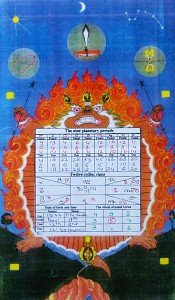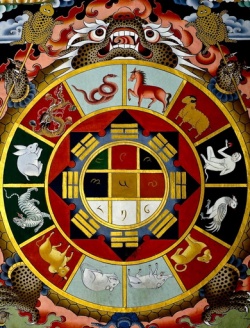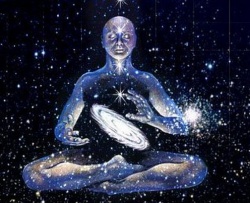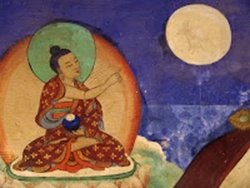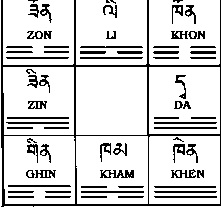Astrology for Tibetan New Year 2009
Herein are some general, and not-so-general, comments about the astrology of the Sino-Tibetan year of the Earth Ox, which for the Han people began on Monday, January 26, 2009, and for the Tibetan people begins on Wednesday, February 25, 2009. As a most charming friend of mine so wryly notes, we have the earth, and then we have the ox... and it seems this is not so light.
Maybe yes, maybe no.
Earth is merely the external element of this year. What the Tibetans call the lus, or "body" element, is to the Chinese known as the "containing note." In fluent practice, the containing note is reckoned as the best measure of fate.
This system seems to originate with Kuei-ku Tzu, who lived in the Chou dynasty (c. 1027-256 BCE). The earliest book where it is mentioned was written by Kuan Lo during the Three Kingdoms (220-265 CE) -- he writes, "By the containing note judge one's fate." Kuan Lo predicted his own death well before the event, and for this, and other demonstrations of craft expertise, is known as the finest fate calculator in all of Chinese history. I also think it probable that he is one of the first to attempt integrating Indian astrology with Chinese astrology. Now, also according to the Tibetans, the system originates in the Chou, in 836 BCE to be exact, with a discourse by no less than Manjushri himself, at Wu Tai Shan, known to Tibetans as the Five Peaks or ribo rtse lnga.
Be all that as it may, below is a picture of what it looks like outside my bedroom window this morning:
With all due deference to the Tibetans, I think I see Manjushri sitting on the mountains, no matter where they might be, and it appears to me that he is still giving discourse. Maybe I am so very wrong, but that is how I feel.
Time and direction are the stagecraft of dreams. The dreams are life, having all the indefinite properties of illusion, yet remaining sticky. We mark off these dreams of life with a linear past, present, and future. We go to and fro, reaching out: pulling in. We ought to enjoy the show but it is good not to believe too much. What we really provide for ourselves by marking time and direction is a kind of fantastic parable of egocentricity; then invested with an idea of the duration of our egocentric selves in some sort of place or point.
That is hardly immortal.
We become controlled by our creations, our dreams of calendar, compass, and clock. We become imprisoned in misery with hopes and fears for the future, trying to predict when we will get "out." We look for all the reasons we stay "in," breeding other sets of hopes and fears for the present and the past.
Why encourage this?
When we first begin to seriously analyze time and direction they seem simple to know yet difficult to explain. As we learn more, the language we are forced to use seems unconnected because we are dealing with unfamiliar concepts. These concepts have an open, spacious, and even boring, featureless nature.
Indeed, there are only slight precedents for the expression in any human language, concerned as language is with the task of communication by symbols rather than evocation by direct experience. Among the possibilities we might want to consider is one which says that some divination systems could be nothing more or less than attempts to refine the languages of man, permitting more intimate experiences with time.
They could be.
They could also be the languages of the intimate experiences, celebrating themselves.
So, in the case of 2009, the containing note is actually celebrating fire -- fire from the sky, or lightning, explained as thog gi me: the fiery thunderbolt. Another most charming friend of mine used to remark, with some irony, "If you don't expect the unexpected, the unexpected never happens," and in this she was of course quite correct. Nevertheless, in a year contained by lightning, one expects unexpected events.
The other basics of the year are its srog, or vitality (earth); the dbang-thang, or destiny (earth); the klung-ta, or luck (water), and the khyams-nyid -- one source translates this as "actual luck" -- which is also water.
If what you know about Tibetan astrology is fundamentally confined to what you read in Philippe Cornu's little book, then we are are here talking about what he calls "sok" (vitality), "lu" (body), "wang thang" (power), and "lung ta" (luck).
Our wonderfully magical numbers are skye-sme, or natal, as Blue 3 (upper metreng); srog-sme, or vitality, as White 6 (middle metreng); dbang-sme, or destiny, as Red 9 (lower metreng).
So, what shall we say about the people of this sa mo glang po year? According to the Tibetans, Earth Female Ox people are stubborn, excessively prideful, barbarous or rough natured, with violent, quarrelsome minds, vulnerable to soil spirits who inhabit the localities where they live, and possessed of bad reputation. They will be confronted by seven obstacles.
Only seven?
Since the "soil spirits," or sa bdag ("Sadak") are so important, and because there is very little information available in the English language, perhaps we should investigate. I have already mentioned them in passing elsewhere, but here we shall require a bit more detail.
We can say there are 1,000 sa bdag that are commonly known, 150 that one should consider on a frequent basis, and 81 that you should keep on the tip of your tongue, so to speak. However, these are all further divided by 1) elements, 2) location in space, and 3) outer, inner, and secret aspects, so you see, the numbers are rather greater than is immediately supposed.
Of the greater numbers, 102 are always with us, and 474 are associated with time. Of the 102 always with us, there are those of the nine subterranean levels, 71 permanent and immutable, and 72 abiding. Of the 474, there are 231 moving spirits of the years, 124 of the months, 81 of the days, and 37 of the hours. One can also see the nine black yearly spirit lords, the nine deities of the magic squares, 45 palace deities, five lesser deities, twelve hidden, dog spirits, and so forth.
But we are most concerned with the king and his court. You rarely see them, so I introduce them here, and tell you where they are this year:
1) King The-se - Northeast
2) Queen Hang-phan - Northeast
3) Crown Prince Te-so - North (also Queen Mother The-khyem)
4) Royal Minister Tsang-kun - West
5) Royal Astrologer Se-ba bla-mkhyen - Southwest (also inner at West, secretly at Northwest)
6) Royal Dog Walker Hang-phan ser-po bya-ra-ba - Northeast
7) Royal Treasurer Se-byi - Southwest
8) Royal Bodyguard-Assassin Se-shar - Southeast
9) Royal Horse Se-ba rang-rta - West
10) Royal Groom Se'u rta-khrid - West
11) Royal Timekeeper Se-bya - North
12) Royal Upholsterer Sa-bdag se-bu gdan-'ding - Northeast
13) Royal Policeman Se-lo sa-'chag kungs-myul - Southeast
14) Royal Sweeper Se-lo sa-'phyag - Southeast
15) Royal Dog Hal-khyi nag-po - East
16) Princess dKar-shan - East
17) Prince sBal-te (her husband - the royal son-in-law) - East
18) General Vang-ging dmarpo - Southwest
19) General Tsang-kun - Northeast (also hidden spirit gNyan ljang)
20) Adjutant Tsang-kun 'phye'o - Northwest
21) Dog-headed Assistant Tsang-kun khyi-mgo - Northwest
22) Advisor Bla-mkhyen phe'u - Southwest
23) Scorpion-head Zin 'phung - South
24) Venomous Pi-ling - North
25) Chief of the Eleven Ministers of the King (symbolizing them) - East
It is fun to say their names really fast, with a Cantonese accent.
In Tibetan geomancy, or sa dpyad, each year is said to fundamentally present directional obstacles and passages. This is represented by the relative positions of the king and his court, which is either carefully calculated or left to a crapshoot, depending upon one's purposes. Once, several years ago, I took an automobile trip with the late Kalu Rinpoche from Pasadena to San Francisco, California. We went up the Highway 101, and fell into conversation about the hills and valleys and so forth. I asked Rinpoche point-blank, if it could be said that Tibetans had added anything at all to geomancy, or if the whole of Tibetan practice was just lifted from Chinese feng shui. He said it was his opinion that the Tibetans copied the Chinese. "Exactly?" I asked. "Exactly," he replied, but added that it was a subject he didn't follow very closely, because he preferred to just look at things. I mention this exchange only to comfort you, should we find obstacles where you would prefer passages. In Sino-Tibetan custom, let me assure you, there is no lack of remedy.
So, we can just look at things, or we can believe that there are fixed and moving spirits, and that in this year there are passages at the South and West. Because I like oblique mischief, I take particular notice of the dog walker, in the Northeast this year, together with four others: three overt and one hidden. Make of that what you will, but bear in mind this is just the yearly array. If we want to include the month, then the story changes. As noted above, if we include the day, we get even more information, and if we include the hour, even then it is not complete, as we must still include the hour of the actual consultation.
And then there are the trigrams to consider. This takes a little more work. For the sake of example, lets say we have a female born in the Earth Ox year 1949. Her mother was born in 1927. In astrological terms, her mother (whether living or dead) is 83 years old (counting one year at birth), and she is 61 years old (counting one year at birth) in this Earth Ox year 2009. We subtract her age from her mother's age, add one, divide by eight, and the remainder is seven. Starting at the trigram "Kham" and counting back in counterclockwise direction seven spaces, we arrive at the trigram "Zin." Consulting the relevant texts, we find that she will "be sustained by blood feuds." Such people are also suicidal. The 'gong po are watching, and when the sa bdag cause harm, there will be no easy solution. The yearly trigram in 2009 is Li for our hypothetical subject. Li relates to fire, while her vitality element in 2009 is earth, relating to Khon. The Li-Khon relationship is known as "corporal punishment," belonging to the worst class of bad conjunctions.
Of course, this is all for our hypothetical subject. To find the indicators for yourself, you must compare your natal elements and so forth to the annual elements -- and to make this easier, we have herein already done all of the annual calculations for you.
